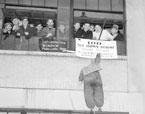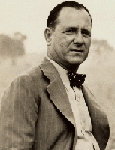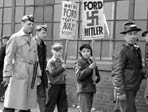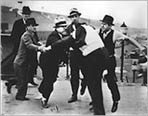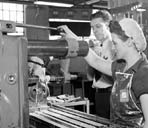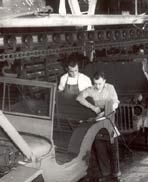
The Degradation of Work Revisited: Workers and Technology in the American Auto Industry, 1900-2000
The Rise of the Unions and the Effects of World War II
Many of these fears diminished with the arrival of unions in the automobile industry in the mid-1930s. Aroused and angered by impossible production-line speeds and work standards, serious safety and health concerns, fears of unemployment, and overly abusive foremen, the United Automobile Workers Union was at the center of the social and economic revolution associated with the rise of industrial unionism. In the mid 1930s, the American Federation of Labor, a federation of craft unions, grappled with the issue of industrial unionism and created a Committee on Industrial Organizations. Soon renamed the Congress of Industrial Organizations, the United Automobile Workers’ Union rapidly became a predominant force in the new national labor movement. With their long accumulated grievances, auto workers readily swarmed into the emerging UAW, especially during and after the widespread sit-down strikes in the automobile and other industries.
For the new UAW, the 1936-37 sit-down strikes fueled the growth of the new industrial unionism. In the summer of 1936, the UAW decided to take on the largest of the “Big Three” automakers—the General Motors Corporation. In Flint, Michigan, the UAW began a secret but intense organizational campaign through the second half of 1936. In December 1936, auto workers used the innovative sit-down strike tactic to prevent the removal of tools and dies so critical for production and to block the importation of strike breakers. Auto workers also sat down in other GM plants around the country. Until outlawed by the Supreme Court in 1938, the sit-down strike captured the imagination of many auto and other industrial workers who suffered grievously from the social and economic misfortunes of the Great Depression. After a sometimes bitter struggle, the UAW proved victorious, winning formal recognition from General Motors in February 1937. Subsequently, a wave of similar sit-down strikes surged through the auto industry. The GM victory brought contracts from a number of smaller auto firms, such as Hudson, Packard, and Studebaker, and also from a number of large and small auto parts firms. Eventually, sit-down strikes in several plants resulted in UAW recognition at Chrysler.
In the summer of 1937, the aggressive and growing UAW attempted to organize the last major holdout—the Ford Motor Company. But Ford proved a tougher nut to crack. The bitter and violent resistance of Harry Bennett’s Service Department and internal UAW factionalism undermined the Ford organizational campaign. At the River Rouge complex, the savage beating administered to Walter Reuther, Richard Frankensteen, and other UAW organizers at the “Battle of the Overpass” revealed how bitterly Ford resisted unionization. This stalled the Ford organizational campaign and ultimately sapped the new union’s capacity to continue with its forward march.
Nonetheless, a few years later, on the eve of World War II, the UAW finally succeeded in bringing the UAW to Ford. A new unionization effort began in the huge River Rouge plant in 1940. A complex social mix of auto workers—unionists and anti-unionists, militants and conservatives, different ethnic and racial groups—all complicated the difficult campaign. After the dismissal of several organizers and workers in the spring of 1941, a spontaneous walkout occurred in the foundry and eventually spread to the entire plant. After another bitter struggle, the UAW finally prevailed due to its successful organization within Detroit’s African-American community. Ford finally agreed to a National Labor Relations Board election. The UAW received over 70% of the vote, won recognition in all Ford plants, and obtained a favorable collective bargaining contract. Once in the UAW, workers negotiated contracts that set limits on many of the more abusive management practices. They established grievance procedures to process complaints and created shop steward systems to patrol the shop floor and settle disputes between workers and shop supervisors.
During the Second World War, the UAW along with the other industrial unions consolidated their membership base through dues check-off systems and maintenance of membership contract provisions. An important technological issue involved the wartime conversion to military production and the later postwar reconversion to civilian production. Moreover, the social composition of the auto workforce dramatically changed as more and more women and African Americans moved into machine and assembly operations to overcome wartime labor shortages and to meet the pressing needs of increased wartime production. In the earlier period, machine work was clearly defined as men’s work and especially as white men’s work. Speaking about work at machines, a black Flint auto worker related: “They assumed that since it ran by a motor it was clean, it was a white man’s job.” To be sure, mechanization and work simplification began to allow some women to perform light machine work, but white worker and management traditions and policies allocated African Americans the hardest and dirtiest production jobs in the paint shops and the foundries. The wartime labor shortages prompted the upgrading of black workers to machine operators and assembly line workers. The U.S. government’s wartime labor policies, especially dues check-off and maintenance of membership, strengthened the UAW’s presence in American automobile firms and protected auto workers from the abuses of the pre-union era.For auto workers, the major technological issue was the conversion to and the reconversion from defense production and the introduction of new workers to the advanced production methods. Always problematic for workers, the shift in production, in this instance from the civilian production of automobiles to military production of war materials and back again, created problems in unlearning and relearning day-to-day work tasks and routines. The severe labor shortages often resulted in the “hoarding” of labor, especially skilled labor, in the new defense plants. With “cost-plus” government contracts, manufacturers often hired extra and sometimes unneeded workers simply to hold them on their payrolls. The increased numbers of women spawned new and different problems for supervisors and managers in the densely masculine shop culture. They often confronted the intractable issues of sexuality, sexism, and sexual harassment at the workplace. The appearance of black men in positions perceived to be “white” ones raised shop floor tensions that sometimes resulted in vicious hate strikes against the recently upgraded African-American workers. Ironically, after World War II ended, gender solidarity prevailed over racial solidarity when managers and white workers accepted black men and purged white women from American auto plants.
<<Previous Section - Next Section>>
Labor under Mass Production: Ford and the Five Dollar Day
More of the Same: The Rise of Sloanism and Flexible Mass Production
Men at Work? Masculinity and Mass Production in the 1920s and 1930s
The Rise of the Unions and the Effects of World War II
Labor and the Post-War Automation Movement
The “Blue Collar Blues” of the 1970s
About the Project | Credits | Contact Us | Student & Teacher Resources | Site Map
©2004 Automobile in American Life and Society
